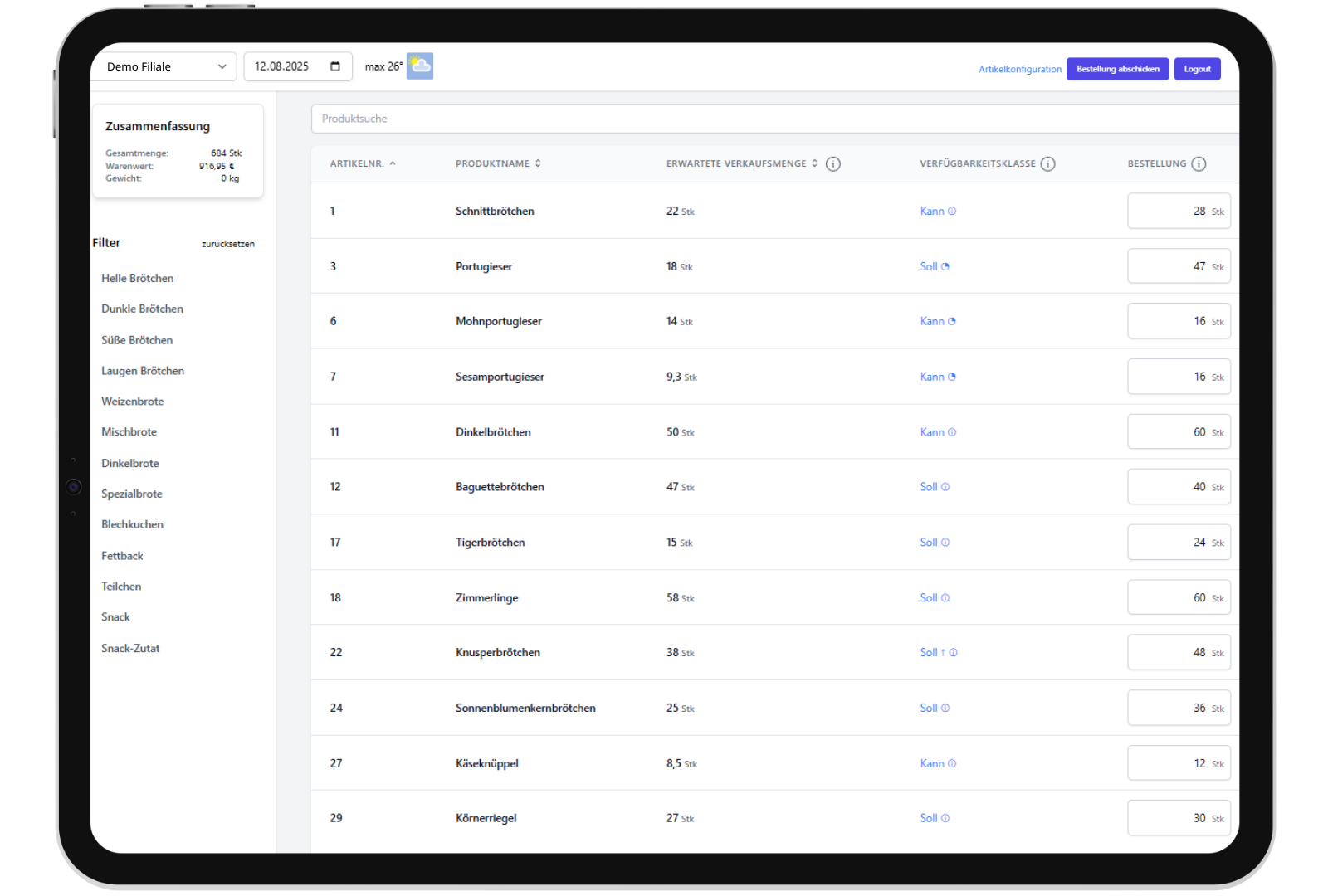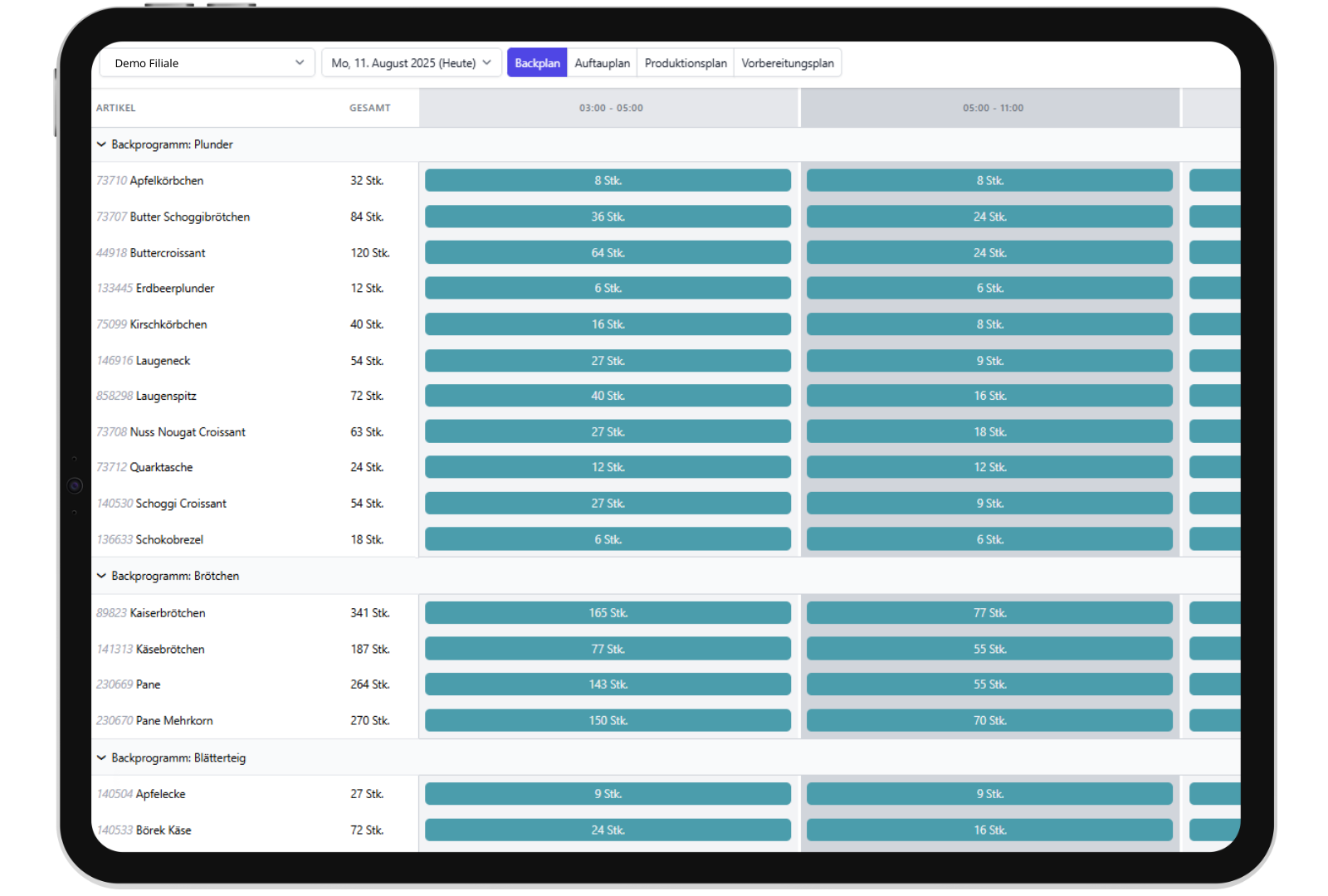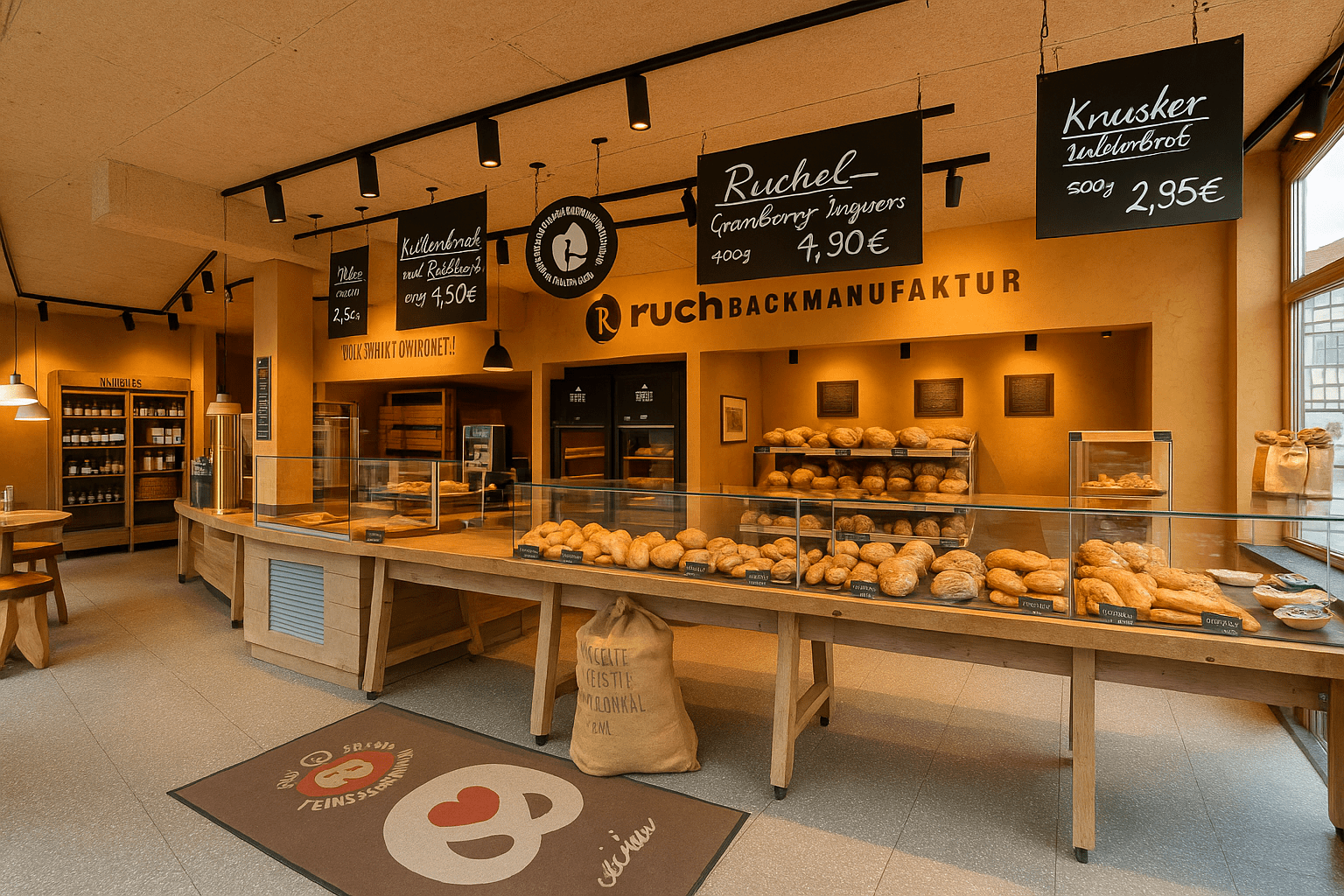From gut feeling to data-driven decisions.
Automated ordering for fresh bakery products.
Boost profit with less waste, higher sales -
having more time for customer interaction.
-min.webp)
Trusted by leading providers:



.webp)


.webp)

Turning complexity into clarity — with AI.
Boost efficiency, streamline operations, and turn insights into impact.

etc.



decision-making

Recommended by
leading bakeries
Prevent early stockouts and reduce waste
Targeted control of product pressure to increase profit
Daily AI-based demand
forecasts for precise ordering.
The order optimization delivers daily, AI-based demand forecasts tailored to your store’s needs. These forecasts drive optimal order quantities for warehouses, suppliers, or central hubs – ensuring full shelves with minimal waste, once a day.


In-store autopilot for the right amount at the right time.
The production plan provides intra-day AI-powered forecasts to ensure optimal product availability throughout the day. By updating predictions multiple times per day, it enables store teams to produce and replenish with precision - right when it matters.
10x
Return on Invest


.webp)




Increase your profits and relieve your staff - get in touch
With foodforecast, you can lead your company into a more sustainable future. Revolutionize your food production with us and minimize food waste. Our goal is to work together to achieve a positive impact on the environment, society and your profit.
Responses
to your most important questions
Yes, seasonal fluctuations and holidays are taken into account in the forecasts
Yes, foodforecast is also suitable for small bakeries with a few branches. There is no minimum number of branches to be able to use the solution. The decision to use the solution is based less on the number of branches and more on the availability and quality of digital sales data.
Our AI solution pays off almost immediately, as our artificial intelligence is immediately ready for use thanks to the training of historical data. This means that companies do not have to go through long training periods or extensive implementation phases to benefit from the benefits of the solution.
This is a decisive advantage of our AI solution, because the AI has already learned how sales are behaving based on historical data. The historical data is used to train AI and make precise forecasts about the demand for goods and to create analyses. In this way, users can immediately benefit from the insights gained from these analyses.
In addition, the solution makes it possible to identify trends and patterns that might have gone undetected before. This can mean that decisions can be made more quickly, which in turn leads to an immediate increase in sales.
Another aspect that contributes to immediate profitability is the user-friendly interface and intuitive usability of the solution. As a result, employees hardly need any time to become familiar with the software. Training is usually short and efficient, meaning the team is quickly up and running to take advantage of the solution.
Immediate profitability is also reflected in the ability to use resources more efficiently. Through accurate sales planning, companies can avoid excess inventory, reduce inventory costs and improve the efficiency of their supply chains.
No, no special previous knowledge is required to use our system. The handling is deliberately simple so that you can start forecasting work quickly and easily. Our goal is to make the process as user-friendly as possible so that you can concentrate on your core business without having to familiarise yourself with complicated technical details.
Easy to use:
The user interface and functions of our system are intuitive and clearly structured. Even without in-depth IT knowledge, you can easily view, analyze and incorporate the forecast data into your ordering processes. The most important functions are designed in such a way that they can be accessed with just a few clicks, and the evaluation of forecasts is automated. This means that you don't have to deal with the manual calculation of order quantities or complex data analyses.
Backed by our 24-hour support:
Should any questions or challenges arise, a personal contact person is always available to help you. We offer comprehensive support, from initial setup to daily use of the system. If necessary, our team will also help you adapt the system to your individual requirements and ensure that everything runs smoothly.
In short, you don't need any special previous knowledge. Our system is designed to be easy for everyone to understand and access. At the same time, you can always count on our team of experts when you need help. In this way, we ensure that you can work optimally with the forecasts right from the start, without long training periods or technical hurdles.
In order to develop an effective and powerful machine learning model, the selection and quality of training data is crucial. Only your sales data is relevant for AI training. This data includes detailed information about the number and type of products sold over various periods of time. Sales data is essential because it reveals patterns in customer buying behavior, reveals seasonal fluctuations, and identifies trends that are critical for predicting future sales and optimizing inventory levels.
1. Relevance and quality of data:
It is important that the data is accurate and reliable. Inaccurate or misleading data can distort the model and lead to incorrect results. Data quality also includes the consistency, completeness, and timeliness of data.
2. Diversity of data:
Diversity of features: In order to build a robust model, it is important to have a variety of characteristics (features) that cover various aspects of the problem being solved.
A variety of examples: A diverse data set ensures that the model is not only trained on specific patterns or stereotypes. This helps to avoid overfitting and improves the model's ability to generalize to new, unknown data.
3. Annotation data:
Labeling: Labeled data is required for supervised learning algorithms. This means that each data point must be provided with the correct answer or classification.
Label quality: The accuracy of the labels is crucial. Incorrectly labeled data can result in an inaccurate model. It is important that labels are consistent and accurate, often ensured through manual verification or automated quality assurance processes.
4. Data volume:
Sufficient amount of data: In general, the more data, the better. A large volume of data helps the model recognize better patterns and understand more complex relationships. However, a balance must also be found between the amount of data and processing costs.
Balance of classes: For classification problems, it is important that the various classes are represented in the data set in a balanced manner in order to ensure a balanced model.
Regardless of this, all data should always be relevant, high-quality, diverse and available in sufficient quantity to train a powerful model. Careful data collection and preparation is therefore essential for the success of machine learning.
For analysis reasons, we also export the return and delivery quantities as well as the article master data.
- Return dates: This data provides the number of unsold products. This helps to improve product quality and customer satisfaction. Returns data can also help identify patterns that could indicate problems in the ordering process, which in turn helps to reduce future returns.
- Delivery quantity data: Information about the quantities of goods delivered is essential to plan replenishment and avoid bottlenecks or overstocks. This data helps to make more accurate predictions about future orders and thus make the supply chain more efficient.
- Item master data: These include detailed information about each product, such as product descriptions, categories, prices, sizes, and colors. Item master data is important in order to correctly classify products and to identify relationships between various attributes and sales figures. They form the basis for a well-founded analysis.
By combining these data types, well-founded decisions can be made based not only on sales figures but also on other aspects of the supply chain. Ultimately, this results in improved efficiency, cost savings, and higher customer satisfaction.
Our methodology ensures that all relevant data is collected and analyzed to achieve the best possible results. Data protection and data security are always maintained so that your data remains secure and confidential.
The lead time for implementing foodforecast depends on various factors, including the complexity of your systems, the number of locations that need to be integrated, and the specific requirements of your company. It usually takes around 4 to 8 weeks from the initial expert interview to the start of the pilot or the provision of forecasts.
1. Expert discussion and needs analysis:
The first step is a detailed consultation in which our experts work with you to analyse your current challenges and goals. This determines which foodforecast modules and functions offer the greatest added value for your company. Based on this needs analysis, we create an individual concept that is tailored to your needs. This phase lays the foundation for the entire implementation and is crucial to avoid subsequent delays.
2. Technical preparation and integration:
In this phase, the technical connection of foodforecast to your existing systems is prepared. This includes the integration of interfaces and the configuration of the data streams required for forecasts. The duration of this step depends heavily on how complex your IT landscape is and how many adjustments are required.
3rd pilot phase:
After the technical set-up, the pilot phase starts. During this period, the forecasts are tested in a real environment and adjusted if necessary. This testing phase is important to ensure that forecasts are accurate and can be seamlessly integrated into your workflow. During the pilot phase, our experts will support you and help you with fine-tuning.
4th planning phase:
In this phase, we work together to find out how our modules create the greatest added value for you and your company. On this basis, we will put together your individual package. We are always on hand to provide you with support and further improvements to ensure smooth operation.
Depending on the initial situation, the introduction of foodforecast requires a total lead time of 4 to 8 weeks. This period includes planning, technical implementation, pilot phase and final launch. Early coordination is crucial for a smooth implementation so that all necessary steps can be optimally planned and implemented. If additional adjustments or complex integrations are necessary, the process can also take longer. In any case, we will closely guide you through all phases and ensure that you can take advantage of the benefits of foodforecast as quickly as possible.











